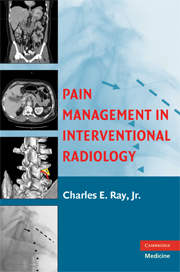Book contents
- Frontmatter
- Contents
- Contributors
- Preface
- Acknowledgments
- 1 Pain Management in Interventional Radiology: An Introduction
- 2 Clinical Evaluation of Low-Back Pain
- PART I LOCOREGIONAL PAIN CONTROL
- 3 Local Anesthetics
- 4 Functional Lumbar Spine Anatomy: A Review
- 5 Percutaneous Vertebroplasty
- 6 Kyphoplasty
- 7 Epidural Steroid Injections
- 8 Selective Nerve Root Blocks
- 9 Discography
- 10 Facet (Zygapophyseal) Joint Injections
- 11 Articular Interventions in Pain Management: A General Approach
- 12 Percutaneous Management of Visceral Pain
- 13 Embolization of Painful Neoplasms
- 14 Image-Guided Ablation of Painful Osteolyses
- 15 Chronic Pelvic Pain in Women
- PART II SYSTEMIC PAIN CONTROL
- Index
- References
9 - Discography
from PART I - LOCOREGIONAL PAIN CONTROL
Published online by Cambridge University Press: 04 September 2009
- Frontmatter
- Contents
- Contributors
- Preface
- Acknowledgments
- 1 Pain Management in Interventional Radiology: An Introduction
- 2 Clinical Evaluation of Low-Back Pain
- PART I LOCOREGIONAL PAIN CONTROL
- 3 Local Anesthetics
- 4 Functional Lumbar Spine Anatomy: A Review
- 5 Percutaneous Vertebroplasty
- 6 Kyphoplasty
- 7 Epidural Steroid Injections
- 8 Selective Nerve Root Blocks
- 9 Discography
- 10 Facet (Zygapophyseal) Joint Injections
- 11 Articular Interventions in Pain Management: A General Approach
- 12 Percutaneous Management of Visceral Pain
- 13 Embolization of Painful Neoplasms
- 14 Image-Guided Ablation of Painful Osteolyses
- 15 Chronic Pelvic Pain in Women
- PART II SYSTEMIC PAIN CONTROL
- Index
- References
Summary
First described in 1948 (1), discography consists of the placement of a needle into a disc space using radiologic guidance. Once the needle is in position, provocative procedures are performed in an attempt to mimic a pain response similar to the patient's underlying symptoms. Additionally, images [either computed tomographic (CT), fluoroscopic, or both] are obtained and interpreted. Discography remains a controversial area, with many individuals on both sides of the debate. Proponents believe that discography remains the least invasive way to settle discordance between imaging findings and clinical symptoms; skeptics claim that the high false-positive rate and lack of evidence suggesting better surgical outcomes following discography make the procedure useless. Whether or not discography is performed in any given institution is largely a function of personal belief in the procedure by both the surgical and radiological consultants rather than firm data documenting its utility.
Discography was first described as a method to confirm the diagnosis of herniated nucleus pulposus (HNP) (1). With the advent of cross-sectional imaging modalities and their high accuracy in diagnosing HNP, the indication for discography has changed. It is now largely used to document discogenic pain in the absence of imaging findings that correlate well with the patient's symptomatology, and to determine the symptomatic level in patients with multilevel disease. Although pain may be associated with an HNP, disc fragmentation and herniation is not the only way by which discs can cause pain.
- Type
- Chapter
- Information
- Pain Management in Interventional Radiology , pp. 131 - 150Publisher: Cambridge University PressPrint publication year: 2008



